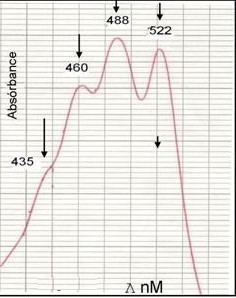 | ||
Granadaene is the trivial name of a non-isoprenoid polyene that constitutes the red pigment characteristic of Streptococcus agalactiae (group B streptococcus).
Contents
Characteristics
Granadaene is an ornithin-rhamno-dodecaene (molecular mass = 676 Da) with a conjugated system made up of a linear chain of 12 conjugated double bonds. Granadaene is dark red, odorless, insoluble in water, methanol, ethanol, diethyl ether, acetone, hexane, dimethyl sulphoxide (DMSO), acetonitrile, tetrahydrofuran, chloroform, and in most solvents, it is soluble in DMSO–0.1% trifluoroacetic acid (TFA). Granadaene, can be extracted from cultures of S.agalactiae in granada broth (granada medium without agar) with 0.1 M potassium hydroxide (KOH) and purified by size-exclusion chromatography on Sephadex LH using DMSO–0.1%TFA.
The ultraviolet-visible absorption spectrum of the granadaene (in DMSO/TFA) is almost identical to that of a carotene with a similar conjugated system of double bonds (e.g. alpha-carotene), that is why the GBS pigment was considered to be a carotene for many years.
Biological relevance
Granadaene is an organic compound produced by S.agalactiae. It is the product of a metabolic pathway similar to that of biosynthesis of fatty acids. The enzymes necessary for the biosynthesis of granadaene in GBS are coded by a gene cluster of 12 genes, the cyl operon, and a pathway for the pigment biosynthesis requiring all the genes of the cyl operon has been proposed. Like the biosynthesis of the pigment, the hemolytic activity requires also in GBS the 12 genes of the cyl operon. The pigment is localized, in GBS, in the cell membrane, where it could play a role in membrane stabilization, similarly to the role of carotenes in other bacterial membranes. It has also been proposed that granadaene is indeed the hemolysin of S.agalactiae, and because the GBS hemolysin is a broad-spectrum cytolysin able to destroy many eukaryotic cells, it is considered an important virulence factor for GBS.
Production of the red pigment granadaene is a phenotypic trait specific to β-hemolytic GBS, and because of that, detection of red colonies from clinical samples, when cultivated on granada medium, allows the straightforward identification of GBS.
In addition to S.agalactiae the presence of granadaene has been reported in Propionibacterium jensenii, where it can cause defects such as red spots in some cheeses. Probably granadaene is also present in other Propionibacterium sp. such as P.thoenii and P.rubrum.
